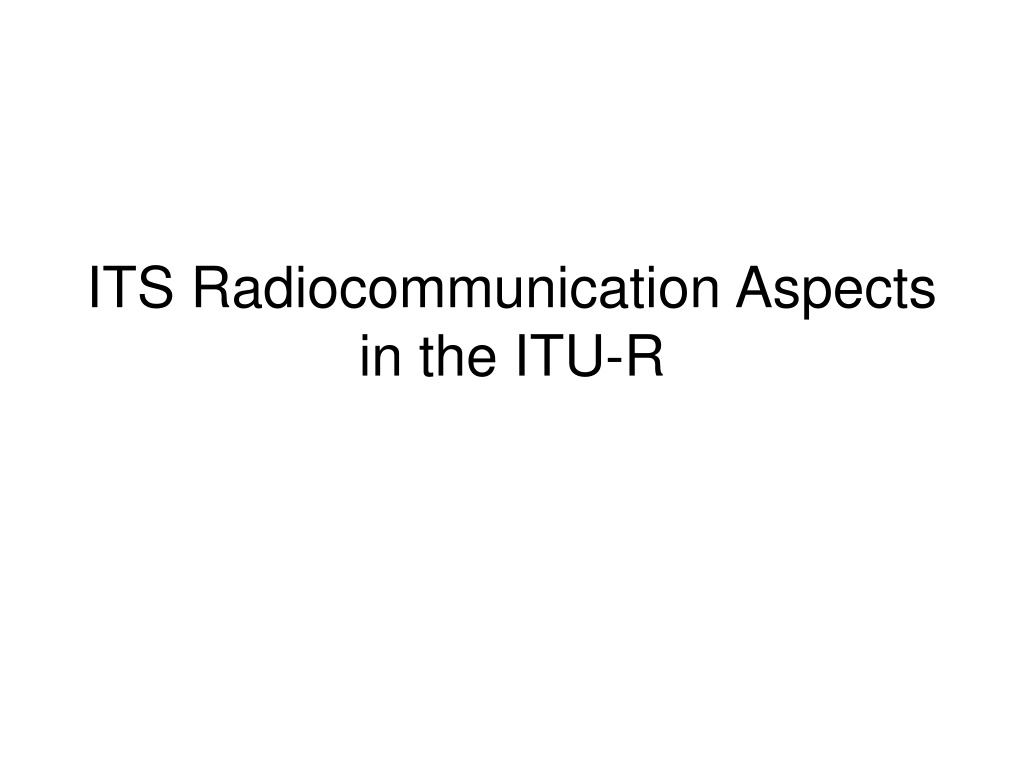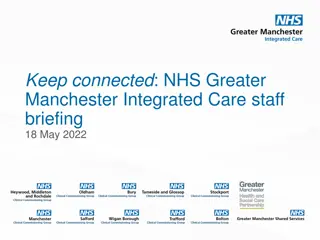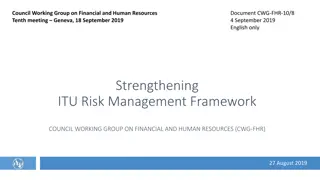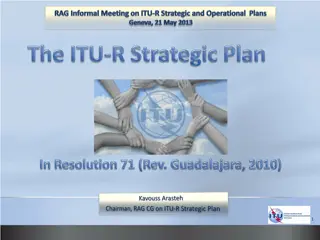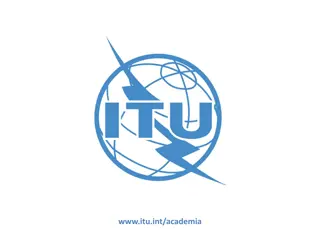Understanding ITU-R and World Radiocommunication Conferences
The International Telecommunication Union (ITU) is a specialized agency of the United Nations, focusing on information and communication technologies. ITU-R, a sector within ITU, addresses radiocommunication aspects and is sub-divided into study groups for specific services. ITU-R's output includes non-binding recommendations and reports, along with binding regulatory decisions made in World Radiocommunication Conferences (WRC) where revisions to Radio Regulations are discussed. WRC plays a significant role in governing worldwide radiocommunication matters.
Download Presentation

Please find below an Image/Link to download the presentation.
The content on the website is provided AS IS for your information and personal use only. It may not be sold, licensed, or shared on other websites without obtaining consent from the author. Download presentation by click this link. If you encounter any issues during the download, it is possible that the publisher has removed the file from their server.
E N D
Presentation Transcript
ITS Radiocommunication Aspects in the ITU-R
What is the ITU The International Telecommunication UNION (ITU) was founded in Paris in 1865 as the International Telegraph Union. In 1947, joined the United Nations as a Specialized Agency dealing with Information and Communication Technologies It includes 193 Member States, and nearly 700 Sector Members (including Academia) It works on the basis of the following sectors within the ITU: The General Secretariat The Radiocommunication Sector (ITU-R) The Telecommunication Standardization Sector (ITU-T) The Telecommunication Development Sector (ITU-D) 2
How does the ITU-R Work Sub-Divided into Study Groups, according to specific Radiocommunication Services, e.g. Land Mobile (terrestrial), including maritime Fixed Service Fixed and Mobile Satellite Services Broadcasting Service ITS is assigned to ITU-R Working Party 5A, which deals with Land mobile service above 30 MHz* (excluding IMT); wireless access in the fixed service; amateur and amateur-satellite services * including the exact frequency of 30 MHz It is part of Study Group 5 (Terrestrial Services) which also includes related ITS topics: Collision Avoidance Radar (61 GHz, 76-79 GHz) Rail Communications (Positive Train Control) Maritime Issues 3
ITU-R Output Most of the ITU-R output is NON-BINDING: Recommendations, Technical Reports, Handbooks, etc. Initiated based on a Study Question (such as Question 205 on ITS) Other output is BINDING upon Member States, such as: Regulatory Decisions by a World Radiocommunication Conference (WRC) through an update of the Radio Regulations Resolutions of a WRC with mandatory language (i.e. shall ) 4
World Radiocommunication Conference The World Radiocommunication Conferences (WRC): An international treaty conference that governs the use and revisions to the Radio Regulations, including the radio-frequency spectrum, the geostationary-satellite and non-geostationary-satellite orbits. Under the terms of the ITU Constitution, a WRC can: revise the Radio Regulations and any associated Frequency assignment and allotment Plans; address any radiocommunication matter of worldwide character; instruct the Radio Regulations Board and the Radiocommunication Bureau, and review their activities; determine Questions for study by the Radiocommunication Assembly and its Study Groups in preparation for future Radiocommunication Conferences. 5
WRC mechanism The work of a World Radiocommunication Conference is based on: An Agenda adopted by Resolution at a previous Conference(s) (i.e. WRC-15), and approved by a subsequent ITU Council (Council 2016) Final agenda set by the ITU Council two years before the conference, with the concurrence of a majority of Member States Contributions from: Regional Organizations (i.e. CITEL, CEPT, APT,..) Administrations A consolidated technical report on each Agenda Item prepared by the Conference Preparatory Meeting (CPM), detailing the activities of the ITU-R Working Parties The Director of the ITU-R Radiocommunication Bureau (BR) The Radio Regulations Board (RRB) The Special Committee on Regulatory and Procedural Matters Other recognized External Organizations (i.e. World Meteorological Organization (WMO), International Civil Aviation Org. (ICAO), ..) 6
WRC-19 Agenda Items a sample Agenda Item 1.12 Global Harmonization of spectrum for ITS Radiocommunications Agenda Item 1.11 Spectrum for Rail Communications (quite similar to ITS, includes highway-rail crossing) Agenda Item 1.13 5G Spectrum Agenda Item 1.16 RLANs (in the 5 GHz band) Study on IoT (aka Machine-Machine communications) WRC-15 successfully concluded on a global spectrum for Collision Avoidance Radar in the 76-79 GHz band WRC-19 is scheduled for 28 October 22 November 2019 The Agenda was set in December 2015 7
WRC-19 Agenda Item 1.12 Title of the Agenda Item at the ITU World Radiocommunication Conference (WRC-2019): 1.12 bands, to the maximum extent possible, for the implementation of evolving Intelligent Transport Systems (ITS) under existing mobile-service allocations, in accordance with Resolution 237 (WRC 15) to consider possible global or regional harmonized frequency Objective: To consider possible global or regional harmonized frequency bands for the implementation of evolving ITS under existing mobile-service allocations. 8
ITS spectrum allocation -for communications- ITS spectrum allocation -for communications- As of July 2016 Frequency (MHz) 5,800 60 GHz band 5,900 5,725 5,875 ISM 755.5 5,770 5,850 764.5 Japan RLAN 5,795 5,815 5,8755,905 63 64 Europe 5,805 5,855 5,925 RLAN 902 928 5,850 5,925 North America RLAN Proposed Deployed Allocated 9
Background and Motivation (1) a) Traffic management and assisting safe driving; b) Spectrum harmonization for ITS applications, which are being used globally or regionally; c) Integrate various technologies, including radiocommunications, into land transportation systems; d) Many new connected vehicles use intelligent technologies in the vehicles combined advanced traffic management, advanced traveler information, advanced public transportation, management systems and/or advanced fleet management systems to improve traffic management; 10
Background and Motivation (2) f) ISO is standardizing ITS (non-radio aspects) in ISO/TC204, including applications for cooperative systems which require vehicle-to-vehicle and vehicle-to-infrastructure radiocommunications; g) service requirements of LTE-based V2X Services for ITS application; 3GPP is standardizing radio interface, system architecture and h) Future vehicular radiocommunication technologies and ITS broadcast systems are emerging; i) Some administrations have harmonized frequency bands for ITS radiocommunication applications, 11
Some Facts and Numbers (Globally) UN Road Safety Collaboration Issued a Decade of Action for Road Safety 2011-2020 Decade s goal: Save 5 million lives, and prevent 50 million injuries Commemorates World Day of Remembrance for Road Traffic Victims - Third Sunday of November About 1.25 million people die each year on the world's roads and between 20 and 50 million sustain non-fatal injuries. Road traffic injuries are the leading cause of death among young people, aged between 15 and 29. 3,400 people die on the road every day ~10 airplanes per DAY!!! Source:Global status report on road safety, www.who.int/roadsafety/en/ 12
ITS in ITU-R Question Q. 51/8 Question Q.205-4/5 As of March 2016 2002 2004 1998 2000 1994 1996 2006 2008 2010 2014 2012 2016 WRC-19 WRC-12 WRC-15 Proposed Initial ITS Work Item M.1890: Guidelines & Objectives M.1310: ITS Objectives & Requirements M.1451: ITS Functionalities (Eliminated) (Eliminated) M.1452-2 M.1452: Short Range Radar (60, 76GHz) M.1452-1 Millimeter Wave ITS Radiocommunication (60GHz) M.1453: 5.8GHz DSRC Short Range Radar (79GHz) M.1453-1 M.1453-2 Individual Technologies Report M.2228 Advanced ITS Radiocommunication M.2084: V2V, V2I applications M.2057 Systems Characteristics WRC-15 A.I. 1.18 79GHz band high-resolution radar Report M.2322 sharing study 13
ITU-R Recommendations & Report (1) ITU-R M.1890 ITS Guidelines & Objectives (04/11) Replacement of: ITU-R M.1310 Transport information and control systems (TICS) Objectives and requirements (10/97) ITU-R M.1452-2 Millimeter wave radiocommunication systems for ITS applications (05/12) Technical and operational characteristics of collision avoidance radar operating at 76 & 79 GHz implemented by ITS industry. 60GHz band radiocommunications system will be deployed. ITU-R M.1453-2 DSRC at 5.8 GHz (06/05) Based on the ARIB, TTA, ETSI and CEN Standards for DSRC, and updated in June 2005. Extensively used by the ITS industry. ITU-R Report M.2228 Advanced ITS Radiocommunication (Rev.1 07/15) Technical report including 700 MHz band ITS systems in Japan and 5.9GHz band in Europe , as well as Applications in Korea . 14
ITU-R Recommendations & Report (2) ITU-R M.2084 (07/15) Radio interface standards of vehicle-to-vehicle and vehicle-to infrastructure communications for intelligent transport systems applications ITU-R Report M.[ITS USAGE] Intelligent transport systems usage Report in ITU Member States This new report ITU-R M.[ITS USAGE], ITS usage in ITU member countries, should harmonize with revision of The usage of ITS in APT countries (APT/AWG/REP-18 Rev.1). 15
ITU-R Technical Studies ITU-R Technical Studies required for completion prior to WRC-19: Identify current and future use of spectrum for ITS applications including autonomous driving systems within frequency bands allocated to a number of radiocommunication services in accordance with the relevant provisions of the Radio . Co-existence with RLAN under WRC-19 Agenda Item 1.16 Studies concerning Wireless Access Systems including radio local area networks in the frequency bands between 5 150 MHz and 5 925 MHz. 16
ITU-R Assignment of Work ITU-R Working Party 5A (Land Mobile) To carry out studies on technical and operational aspects of evolving ITS implementation using existing mobile-service allocations, Assignment based on invites ITU-R of Resolution 237(WRC 15) Note: In WP 5A, Work Plan on Agenda Item 1.12 has been created as Attachment 9 to Doc. 5A/114. 17
What is needed from External Organizations What is needed from ISO/TC204 (WG 14, WG 16), or the ITU s Collaboration on Communication Standards, or any other External Organization (including ARIB, ETSI, SAE, etc..): Any standard/report that provides technical, operational and systems characteristics of ITS in any band Any deployment/projected numbers (i.e. total number of deployed systems, or projections..) Any benefits studies (i.e. contributions of ITS toward road/vehicle safety, etc.) Identification of other ITS safety-related applications that may benefit from global/regional harmonization 18
Conclusion A significant accomplishment for the ITS industry to a place an Agenda Item at the level of a WRC Noting that WRC-19 is a major conference to allocate spectrum for Mobile Broadband on a global level (i.e. identification of spectrum for 5G ) Previous attempts to add a WRC Agenda Item were not successful, as the need for global harmonization did not materialize ITU-R cannot perform the identified tasks independently This is a perfect task (or example) for the involvement of the Collaboration on ITS Communication Standards, in general; and ISO/TC204 or ETSI TC ITS in particular 19
WRC U.S. preparation process U.S. Preparatory Organization WRC-19 OAS /CITEL Preferred Optional CPM19-2 Negotiation of final technical input to the WRC State Department ITU-R Study Groups, Working Parties & Joint Task Groups Negotiation of technical study results NTIA FCC IRAC RCS WRC-12 WAC U.S. Preparatory SGs, WPs, JTGs U.S. preparation of technical inputs RCS WGs WAC IWGs Organization of ITU-R CPM19-1 U.S. View and Proposal Preparation U.S. Input into ITU-R Technical Preparation 2 0
Contact Information To participate in the U.S. Preparations for ITU-R: State/local/Federal Agencies: Tom Schaffnit (Volpe) Tom.Schaffnit@dot.gov Private Sector (including SDOs, Academia, etc.): Dante Ibarra (FCC) dante.ibarra@fcc.gov U.S. Head-of Delegation to ITU-R WP 5A: Dante Ibarra U.S. Head-of-Delegation to ITU-R SG 5: Paul Najarian najarianpb@state.gov U.S. Head-of-Delegation to WRC-19: TBD Usually nominated 6-month prior to a WRC 21
